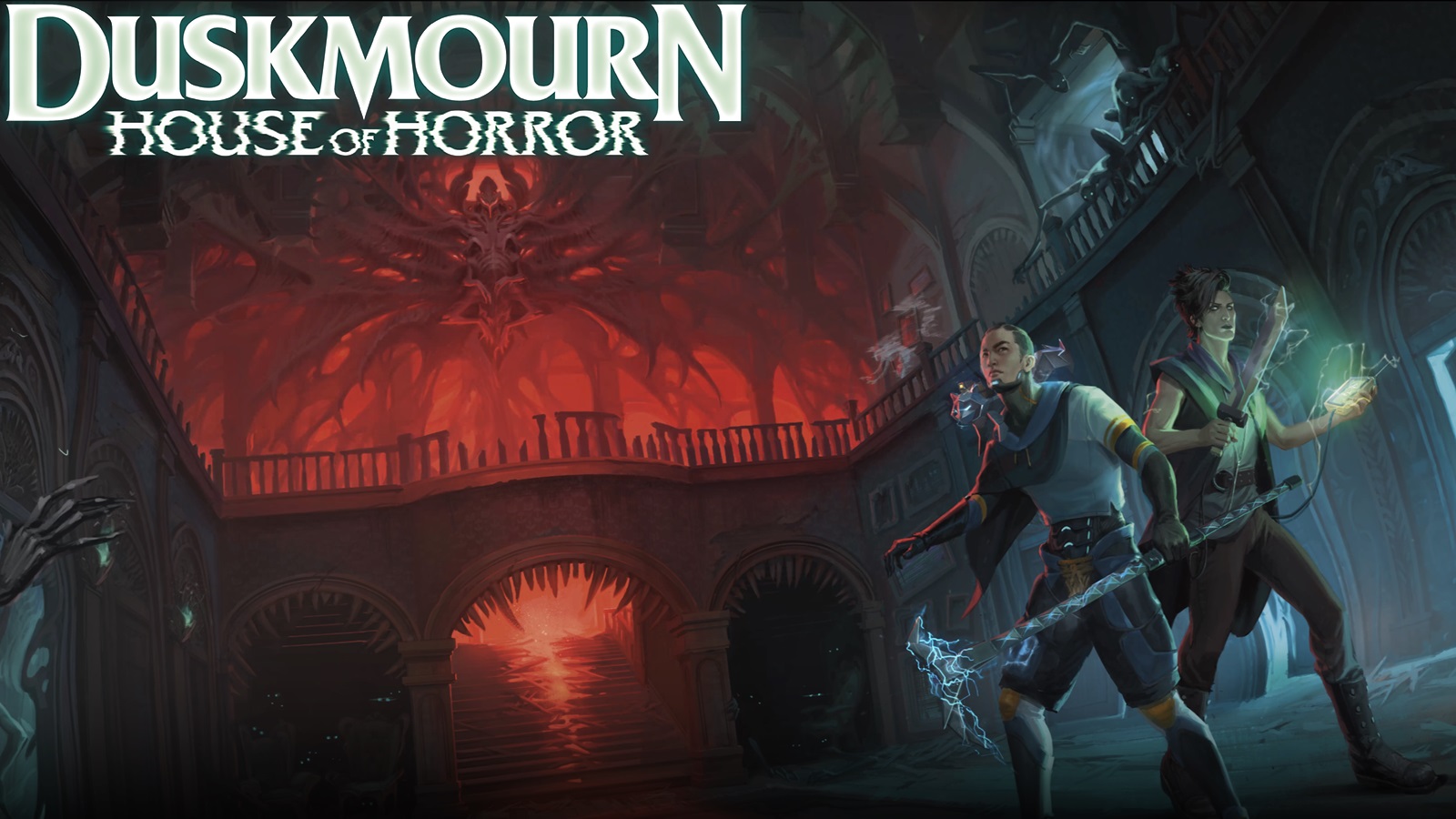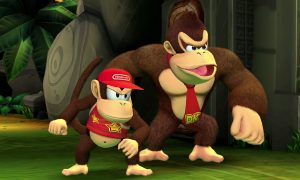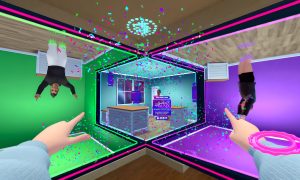Our last standard set for 2024 (not counting Foundations) is Duskmourn: House of Horror. Another plane new to the multiverse, inspired by the horror movies of the 1980s. Duskmourn is an interesting idea as it revolves around a plane that is one enormous “house.” You can never leave the house, and death lurks around every corner. Can you tell this set began development during the pandemic? As a horror fan, I’m excited to add another horror-inspired plane to Magic. I’ve always enjoyed the jaunts into Innistrad, but you can only go “vampires, werewolves, and zombies, oh my!” so many times. So let’s book a stay at Duskmourn and see what kind of Airbnb review we’re going to give it.
Overview – Enter the Enigma
Let’s start with the mechanics and see how well they translate the horror theme. First and foremost are Rooms. Rooms are a split card that is an enchantment. You can cast the card for either side of the Room and can later “unlock” the other side for that Room’s mana cost.
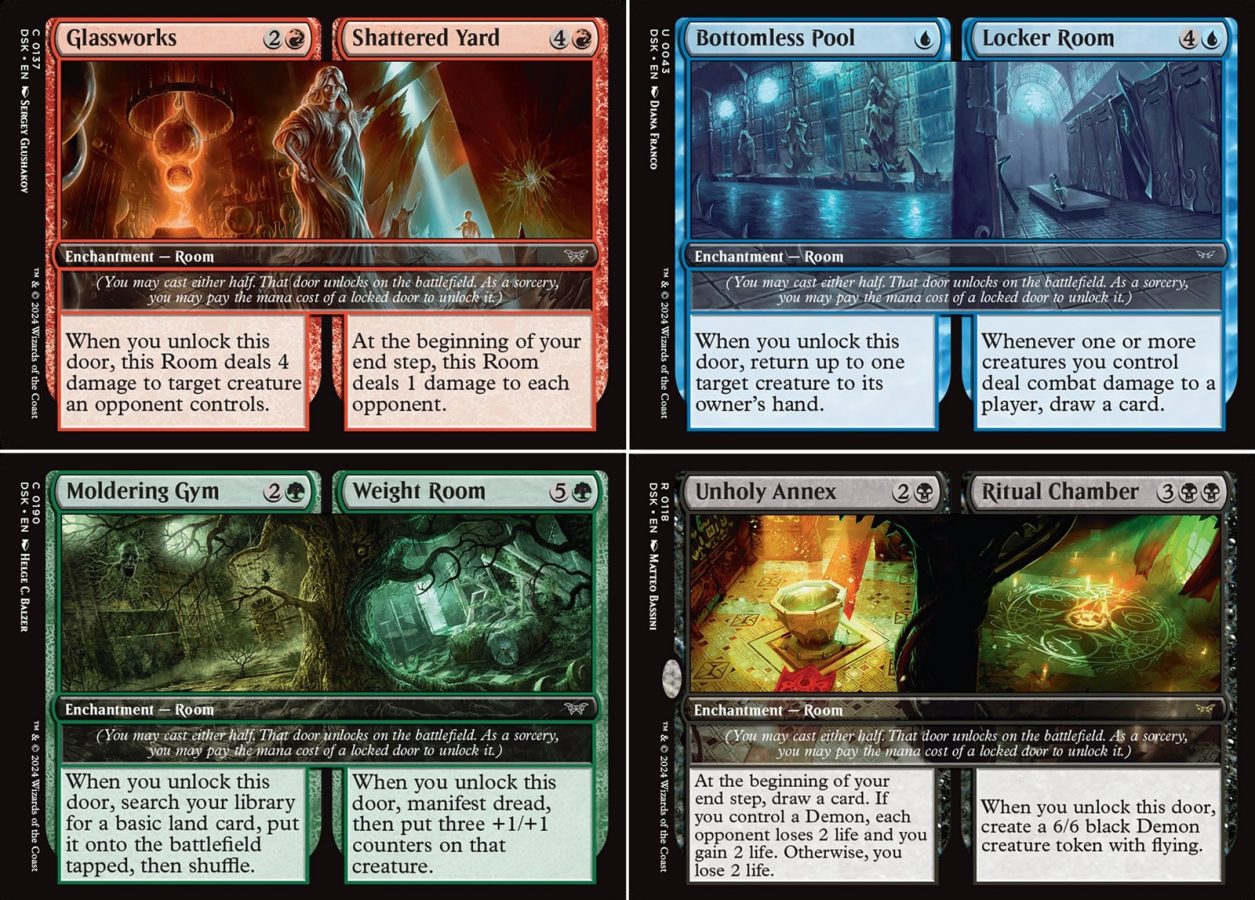
Four Room cards
Next is a new ability keyword, Eerie. Eerie triggers when an enchantment enters, or when a Room is unlocked. This goes hand in hand with the Rooms. You’ll notice that Eerie follows the iterative design that we’ve seen a lot lately as Eerie is an update to the Constellation mechanic from Theros. This will come up later as we examine the pros and cons of Duskmourn’s set design.
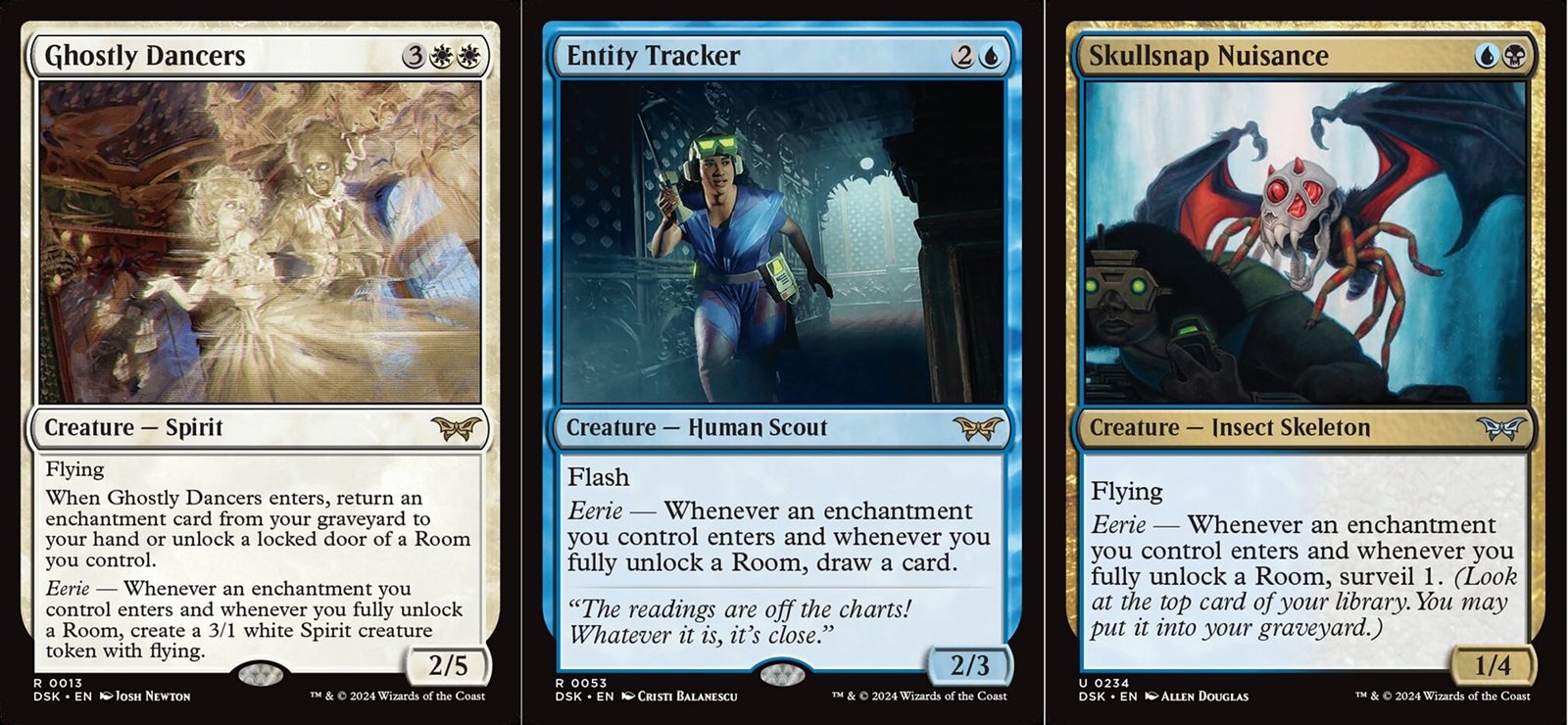
Three Eerie cards
Survival is another new ability keyword. Survival will trigger if that creature is tapped at the beginning of the second main phase. Thematically, this is supposed to represent the creature surviving combat, but the mechanic does not care how the creature was tapped. As we will see there are ways in Duskmourn to enable Survival that don’t involve the combat step.
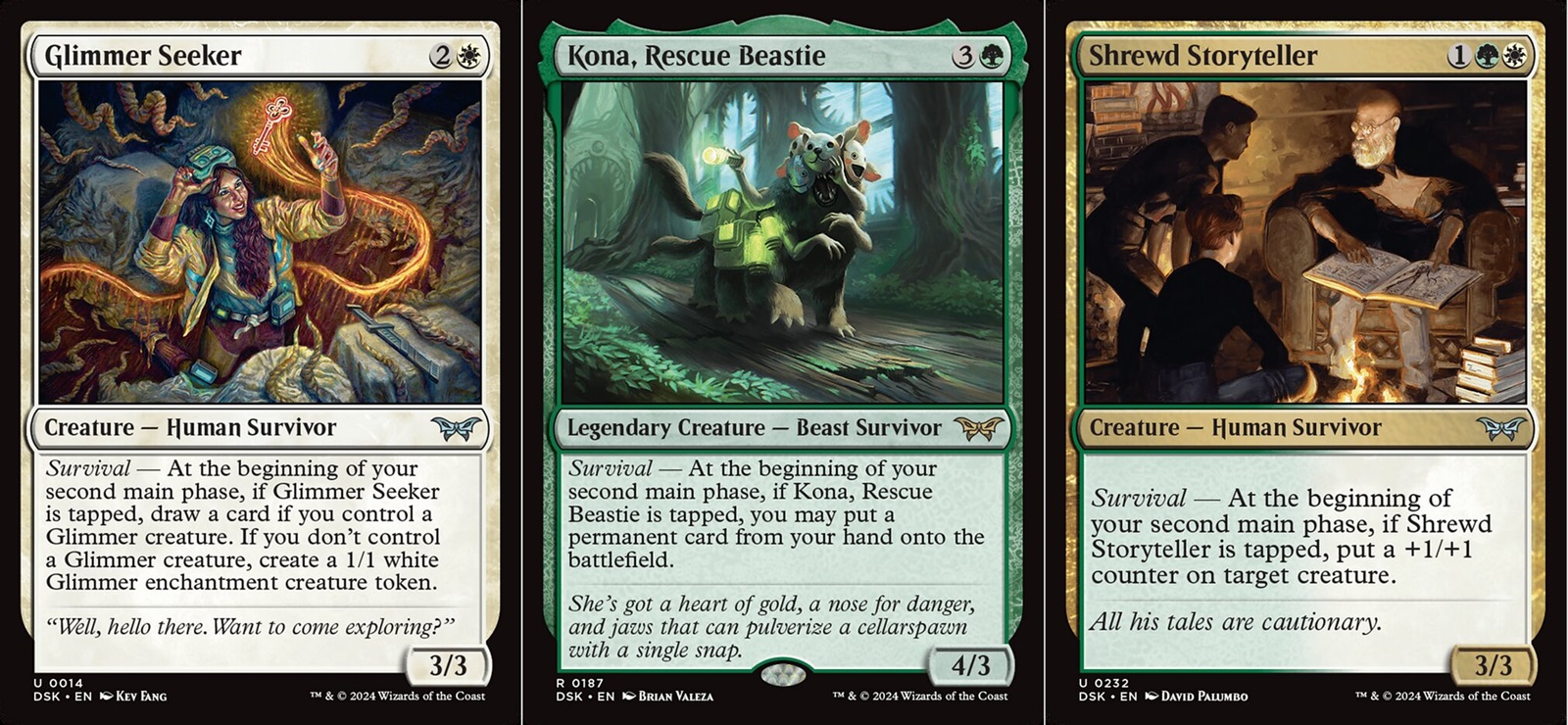
Three Survival cards
Manifest Dread is a new variant of… Manifest. Manifest Dread is a strict upgrade as this allows you to look at the top two cards of your deck, choose one to Manifest, and the other to go into your graveyard. Manifest has you place the selected card facedown as a 2/2 which can be turned faceup later for its mana cost if it’s a creature.
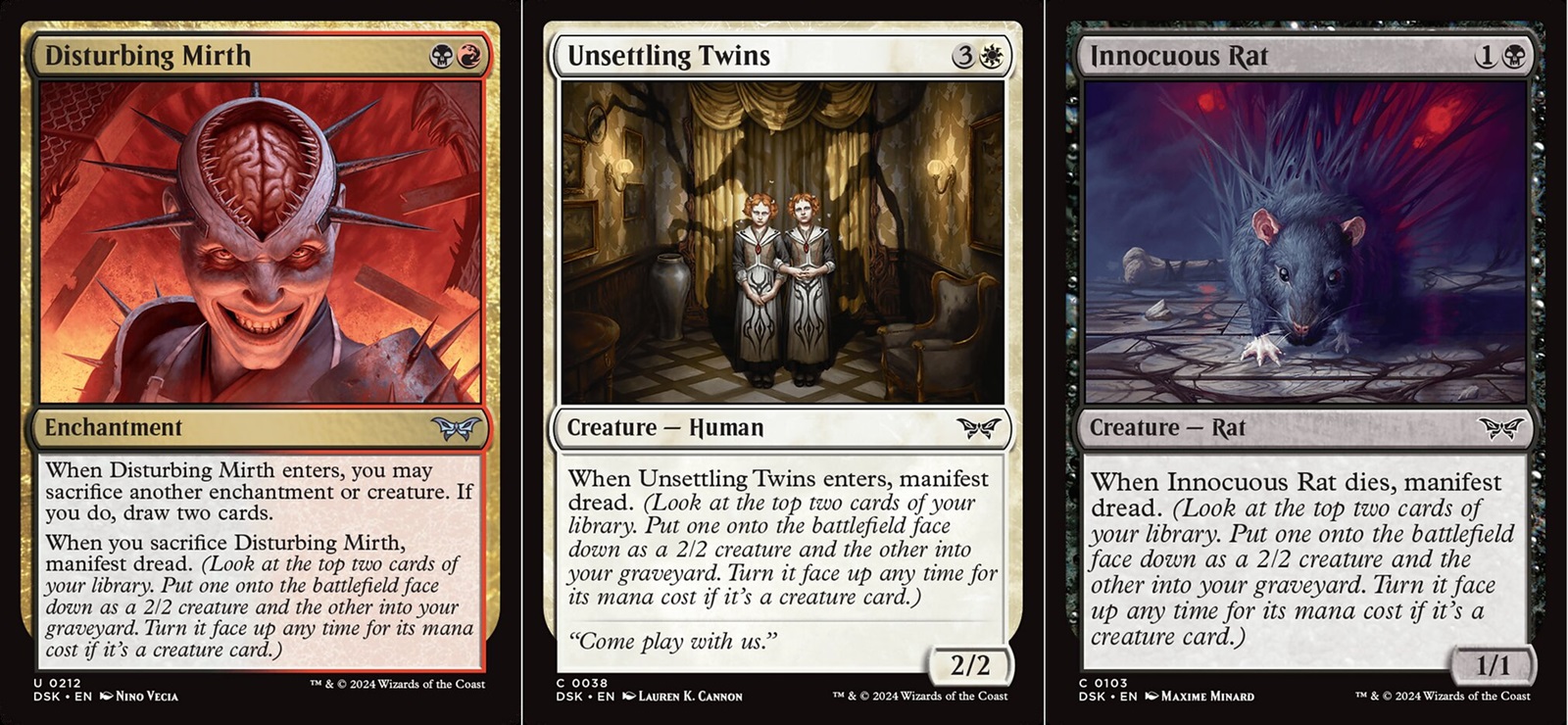
Three Manifest Dread cards
Delirium makes a return as a way for Duskmourn to use the graveyard. Delirium enhances cards when you have four or more card types in your graveyard. Lastly, there are a couple of five-card cycles that are new and pop up enough to warrant mentioning. The “Overlords” are five enchantment creatures that have a new keyword – Impending. A creature cast for its Impending cost enters as an enchantment and slowly ticks down its Impending counters until it becomes a creature. The opposite of Impending, there are the Enduring cards. These five creatures start as creatures, but if killed, they return as an enchantment.
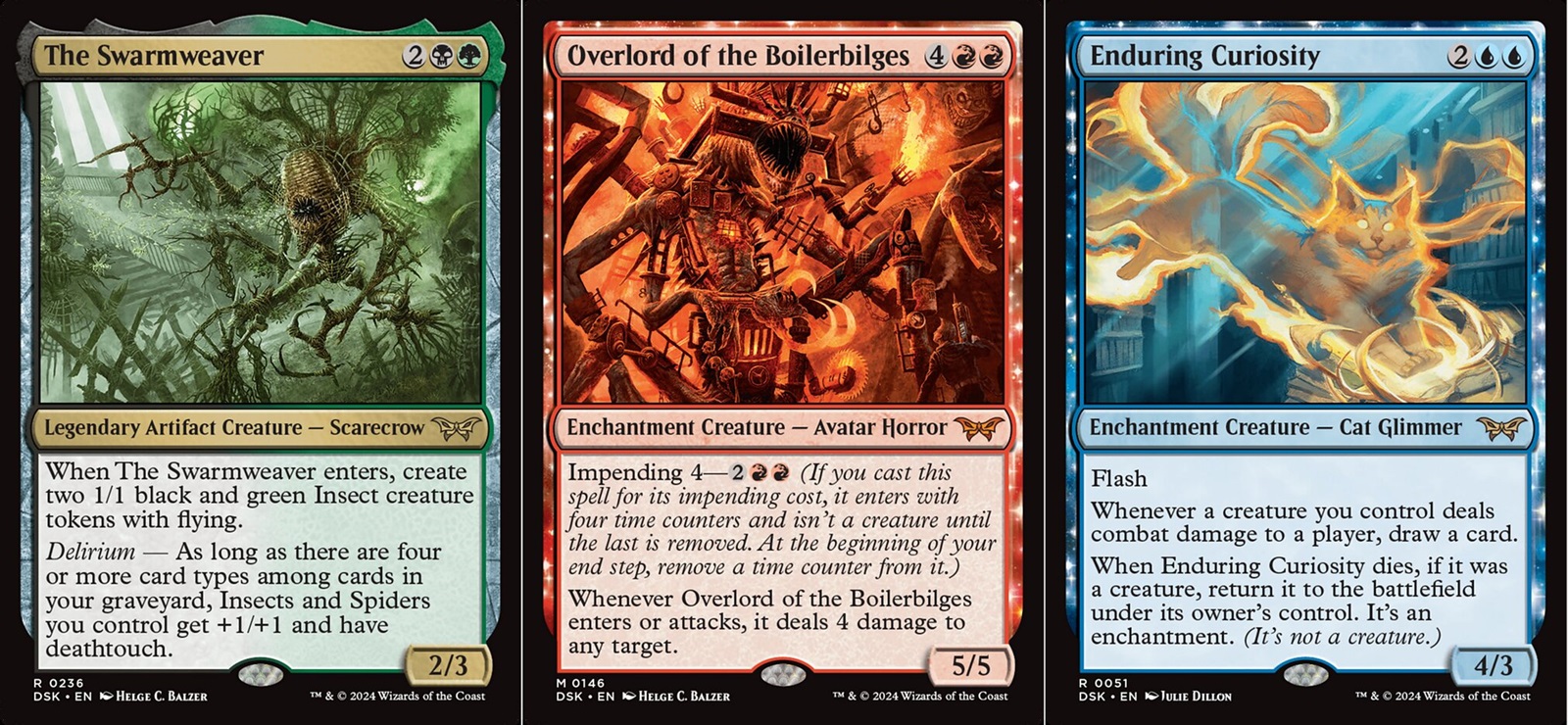
A Delirium card, an Overlord card, and an Enduring card
Pros – Optimistic Scavenger
I’ll just go ahead and let the cat out of the bag. I like Duskmourn quite a bit. I still have a hard time articulating exactly why. Duskmourn is a fun set, but it also doesn’t do anything particularly different than past Magic sets. It’s the sort of solid workhorse that comes and goes without much fanfare. If the horror angle is your jam, you’ll likely get more out of the set, and if not you might pass it by. Maybe it’s because Duskmourn is the most “normal” draft set mechanically in a while. Duskmourn just feels very conventional. Duskmourn doesn’t feel like you’re pushed into any particular direction while other sets this year varied wildly in style and power level. Bloomburrow almost exclusively wanted you in two color pairs. The opposite of that was Modern Horizons III, where you could draft just about anything. Duskmourn is making good use of previous ideas, updated to fit its horror setting, but those ideas feel familiar.
Duskmourn doesn’t do anything particularly new, but its bones do a good job of supporting its theme and setting. A lot of cards in Duskmourn are enchantments and this subtheme helps communicate the unsettling plane. You get the sense that there’s a persistent nature to the magic within Duskmourn. Since Rooms are enchantments, they’re common across all the draft archetypes. Playing out a lot of Rooms does feel like exploring a creepy old house that doesn’t make any sense. Rooms are an interesting design, as they accrue small incremental value the more you play them. If you’re facing a Room deck, you might get squashed by the house your opponent is building.
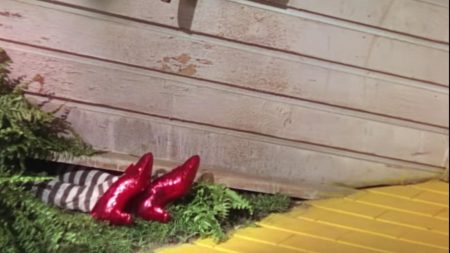
Me playing Duskmourn.
All those enchantments are important to Eerie cards and ensuring you have enough enchantments or Rooms for Eerie helps drive your draft decisions. This is a bread-and-butter synergy found all over Magic, but mechanics like these make up the backbone of design as they help players make their draft choices.
Survival is mostly found on white and green cards, signifying those colors struggling in such an oppressively evil environment. Thematically, this is another great idea. Mechanically Survival is an interesting risk and reward choice. Do you risk your creatures in combat in the hope they get stronger? There are also ways to set off Survival that don’t involve combat. Your opponent might tap down one of your Survival creatures which just makes it come back stronger later. There are even a few cards in white/green that you can Crew which also enables Survival.
I’m almost mad at how good Manifest Dread is mechanically and thematically. Mechanically, it offers card information, a creature into play, and a card into your graveyard. Why is all of that good? Do I want to put a card in my graveyard? Manifest Dread offers you a much more informed choice about what cards you’re drawing or not drawing. Putting a card into your graveyard helps power Delirium and can help you trash cards useless cards. Manifest Dread only to see two lands? Well, at least you’re not drawing those two lands now. Manifest Dread also isn’t so pervasive that I find it annoying. Murders at Karlov Manor had a similar mechanic called Disguise. It was a key part of that set and I just found all the hidden creatures exhausting. Here in Duskmourn, it’s thematic to be frightened of facedown cards and it feels more special as they are less frequent. Reanimation (bringing back cards from your graveyard) is also more common in Duskmourn and here Manifest Dread can also set you up to reanimate a powerful creature.
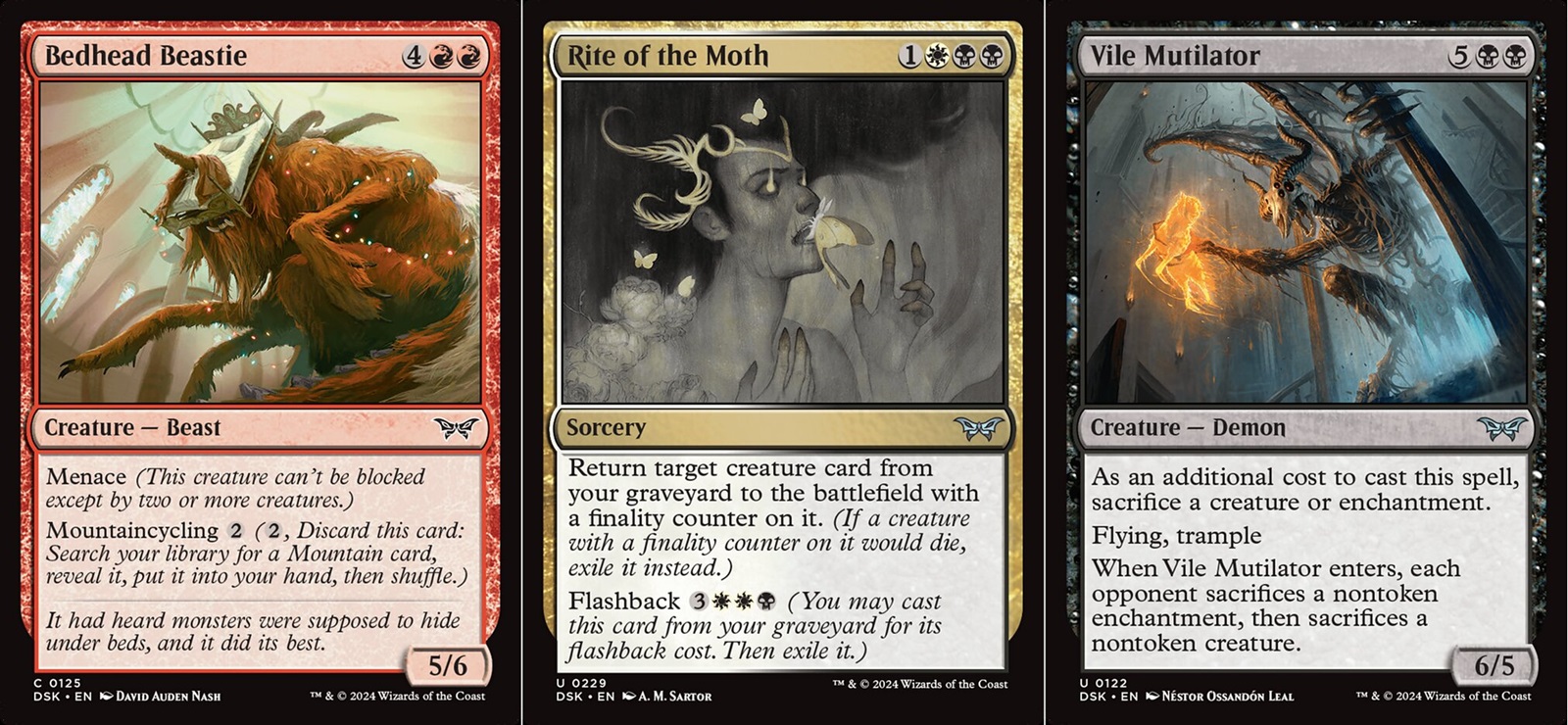
A new land cycling card, a reanimator spells, and a good reanimator target
Due to their rarity, the Impending and Enduring cards aren’t as important for the draft. When they do show up they are a ton of fun to play with. Overall, Duskmourn is a slower set that focuses on the back-and-forth play that is the heart of Magic. With more graveyard shenanigans and reanimation around, games are usually longer. Maybe the biggest pro and con to Duskmourn is that it just feels like a well-rounded set. There are new dual lands, there are new land cyclers, and new twists on established mechanics. From these tools, you can draft a lot of different decks.
I will also mention the Duskmourn Commander decks as they have an extra inclusion in the form of ten Scheme cards for an updated Archenemy game. Archenemy is a way to play Magic in a 1vs3 format where three players play as a team against the Archenemy player. The Scheme cards are for the Archenemy player as they provide powerful game-changing effects. Archenemy is an older format and these new Scheme cards update the Archenemy rules to be more in line with Commander. I’m always for these types of inclusions in Commander products as they’re just additional value. Do I want to play a lot of Archenemy? No, but it’s nice to have the option.
Cons – Cursed Recording
As good as Duskmourn is, it’s still not perfect. I’m still not a fan of facedown cards in draft, but I like Duskmourn enough that I’ll tolerate them. Manifest Dread can still “miss” and when that happens, it is an extra frowny face. It’s possible to look at your next two cards for Manifest Dread and say, “Oh great, that’s two spells I need right now that I will no longer draw. I have lost this game.” In terms of other design complaints, I don’t have anything else. Maybe the double-edged sword is that design-wise Duskmourn feels normal. If you were to ask me to compare Duskmourn’s design, I’d point you to Wilds of Eldraine from last year as a similar enchantment-focused set. Is that bad? No, but maybe you’d rather play Wilds of Eldraine.
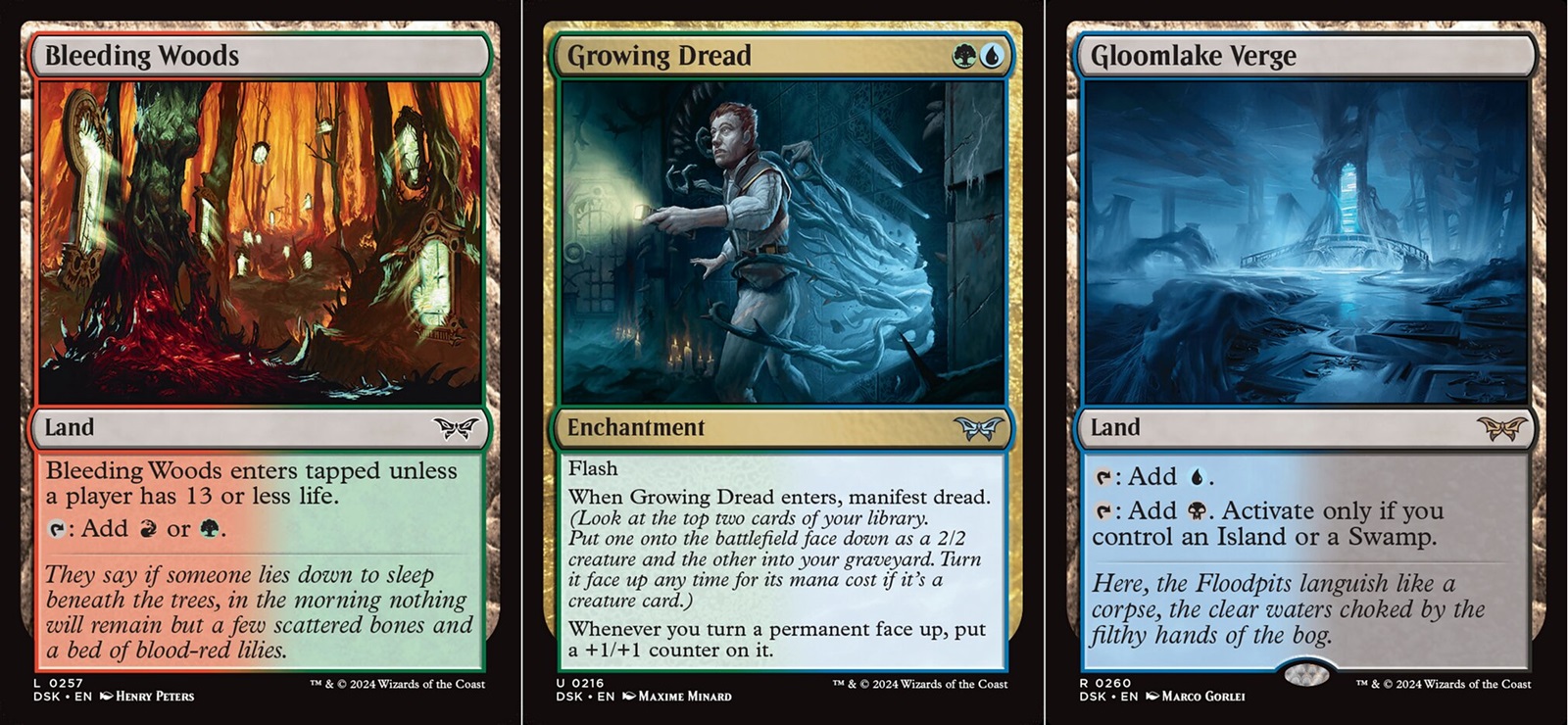
New lands types and a thematic signpost uncommon
My only other criticism is about some of the theming within Duskmourn. I just find it weird there’s now an in-universe Magic card called Baseball Bat. (Another example would be Acrobatic Cheerleader.) This seems like a huge nitpick, but for me, it’s stemming from the overall theming throughout the year. I’ve generally enjoyed the sets in 2024, but a lot of the theming has felt very “on the nose” with a lot of callbacks/references to real-world stuff. Perhaps I have found my bridge too far and yes, it IS weird that it’s a baseball bat. I even like the movie references in Duskmourn, so why does Baseball Bat bother me? I don’t know exactly. Perhaps it feels like the callbacks across all the 2024 sets are finally diluting Magic’s own identity.
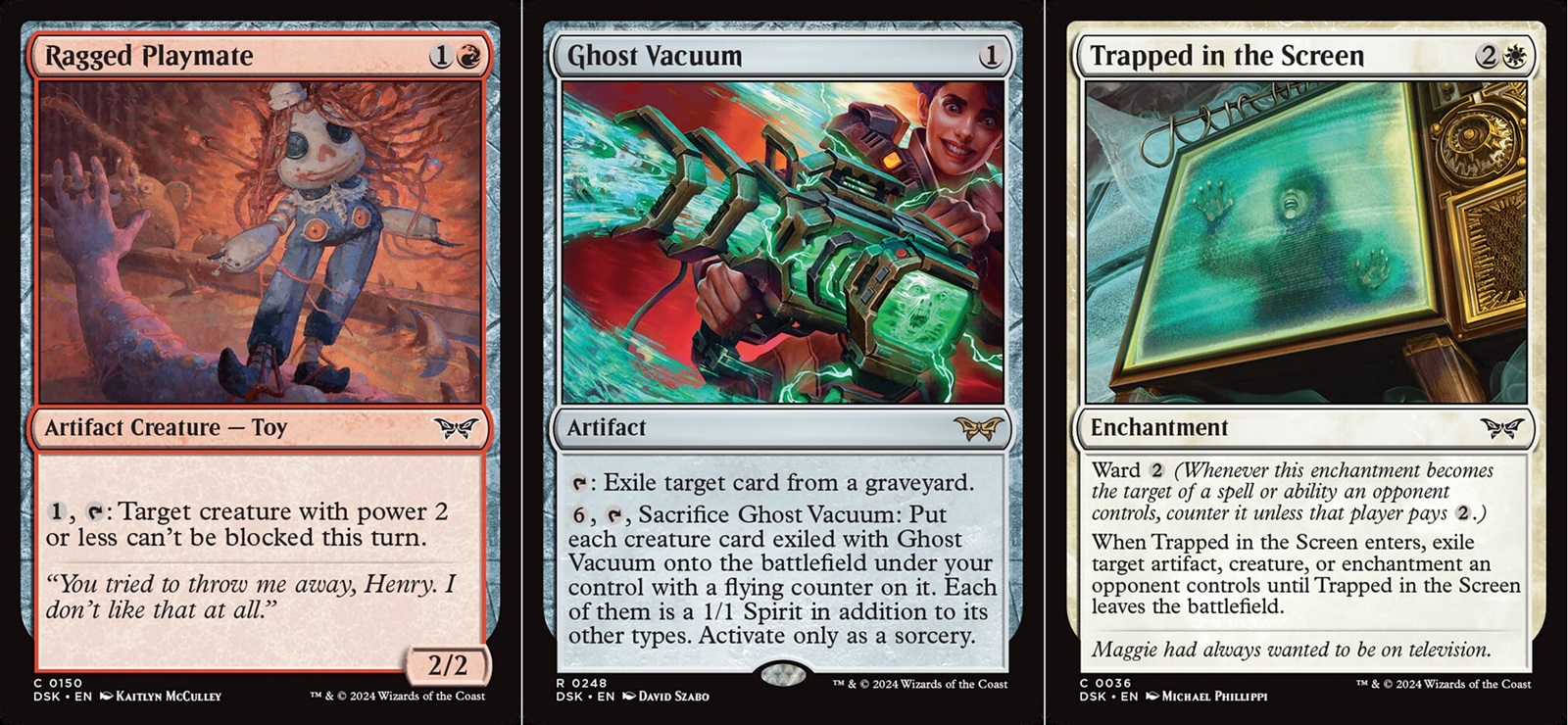
Examples of cards that feel too “on the nose.” Also, it’s weird to me that the word television is now on a Magic card.
Artwork – Abhorrent Oculus
I love the artwork across Duskmourn. Note my previous complaint about Baseball Bat is with the theming, not the actual artwork of the card. Baseball Bat’s artwork is great, and that thing looks very painful to be struck by. I feel like there isn’t going to be much middle ground, as the artwork is indeed horrifying. You’ll look at so many cards and say, “That creature has too many hands/eyes/teeth/etc!” It is a horror set, after all. Just click on this link for The Jolly Balloon Man. If you like what you see, great! If not, you should start running…he’s very fast.
While I love the standard artwork, there are just too many art variants. Some of them are found only in collector boosters so you won’t come across them if you’re just drafting the set, but just to name a few: Showcase Frame, Borderless Frame, Double Exposure Frame, Japanese Showcase Frame, and Lurking Evil Variant Frame. That’s a lot of alternate artworks…it’s too many. Though, all of the artwork is fantastic.
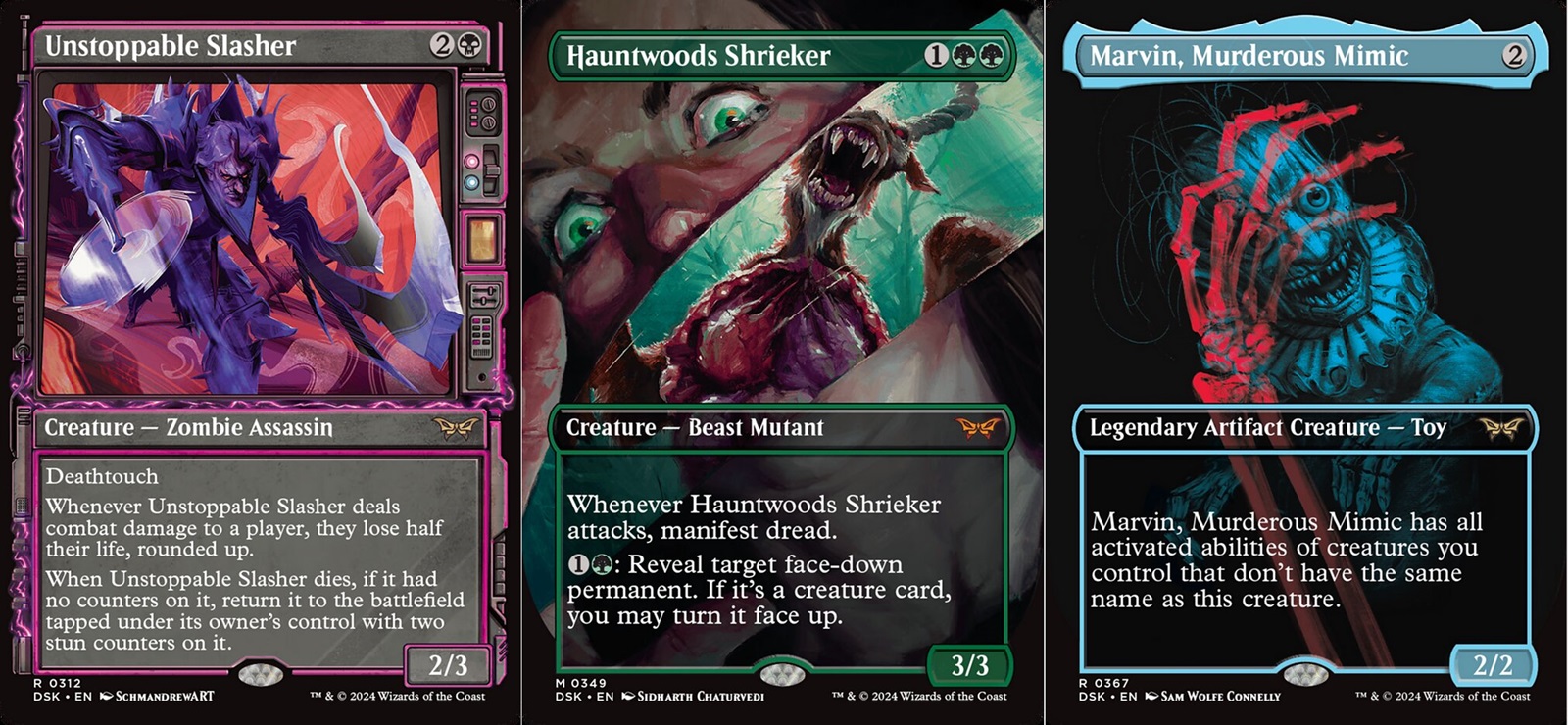
A Duskmourn showcase frame, a borderless frame, and a double exposure frame
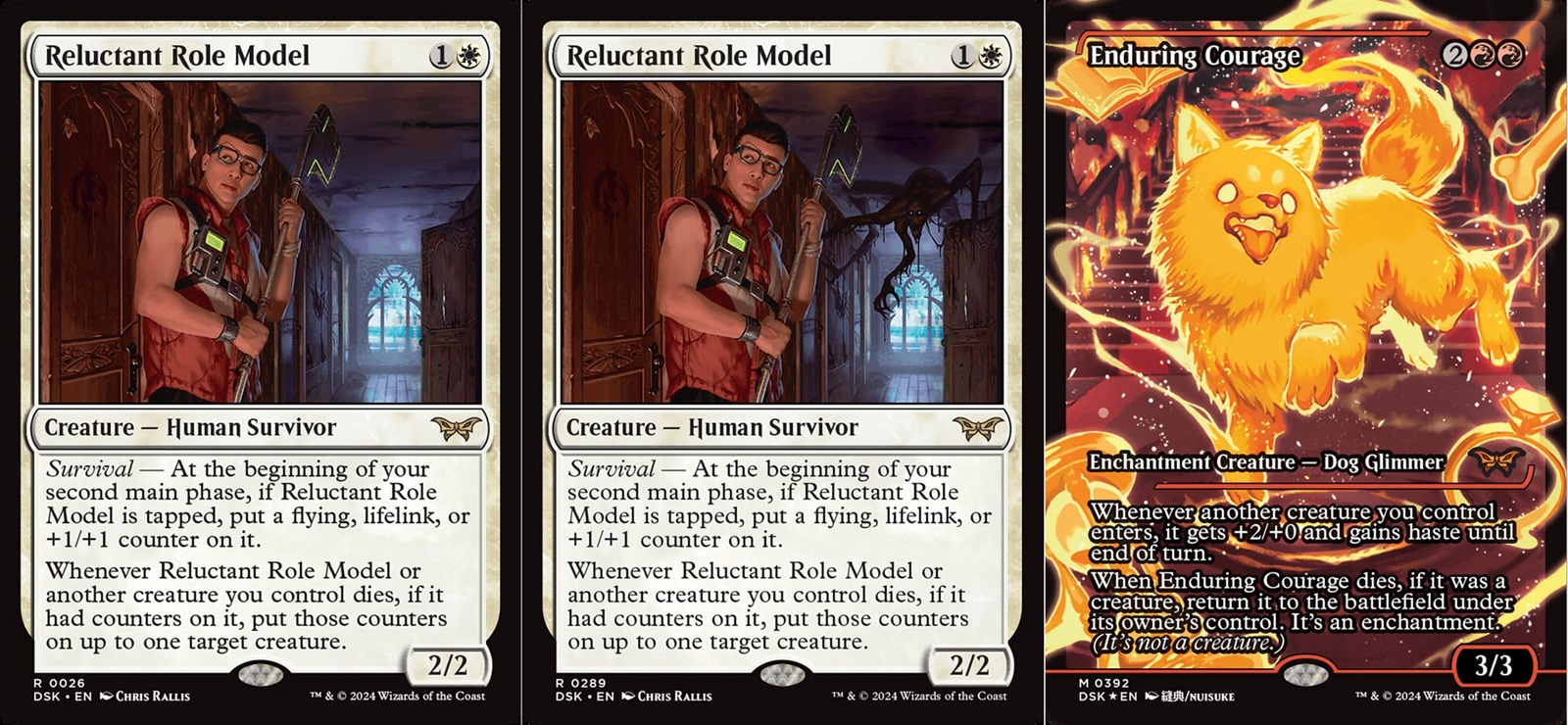
A normal frame, a lurking evil frame, and a Japanese showcase frame
I do love the Lurking Evil Variant Frame that shows an extra monster creeping nearby. That particular bit of theming is great. Did you really see something lurking in the shadows, or is it just your imagination? The Showcase Frame features a TV screen-style border that is present in the style/lore of Duskmourn. Once again, the more modern style seems out of place for me and I don’t like the Showcase Frames compared to the regular artwork.
Chris began tabletop gaming in college and quickly fell into the addictive world of cardboard. Beginning with D&D and Catan he became an enthusiast of all things gaming; analog or digital. Chris, now a relapsed MtG player, loves connecting with people via gaming through RPGs, board games, and video games. A particular favorite is testing friendships through social deduction games.

Duskmourn: House of Horror is a fun solid Magic: The Gathering set. I love the 1980s horror-inspired setting…mostly. There are bits of theme that seem out of place for Magic: The Gathering. With that said the core set design is a great example of what makes Magic fun. Duskmourn focuses on back-and-forth gameplay, enabling longer games through its design choices. The new mechanics are good iterations of established designs. The horror setting of Duskmourn makes it feel weird to say the actual set design feels conventional, but that design is still a lot of fun. If you’re looking for more spooks in your Magic: The Gathering, Duskmourn is a good choice.
PROS
- The set design feels very conventional and is a lot of fun
- Artwork is fantastic
- Commander decks feature new Archenemy cards
CONS
- The set design feels very conventional and is similar to previous designs
- Some theming feels odd
- Too many art variants
See below for our list of partners and affiliates:
